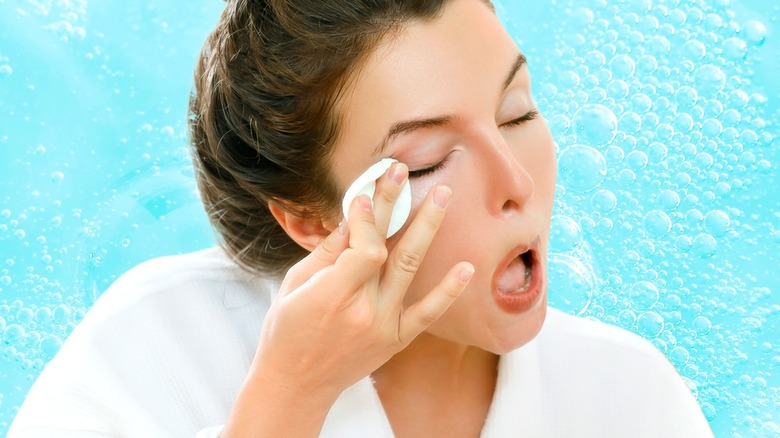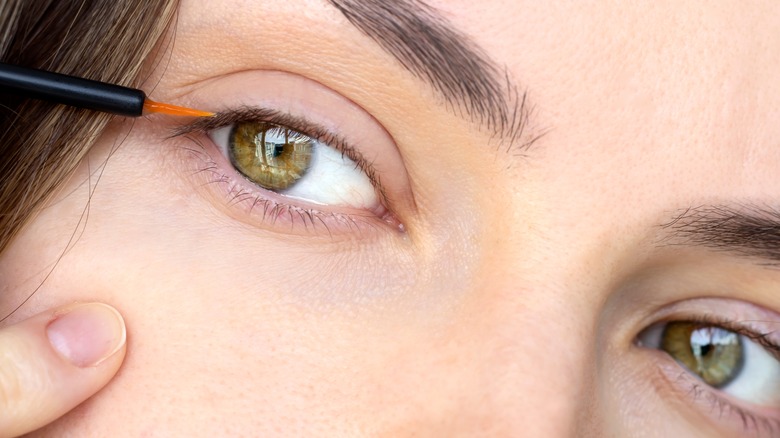The Dermatologist-Approved Way To Remove Stubborn Mascara
We may receive a commission on purchases made from links.
Regardless of whether you're a lash extension lover or au naturel enthusiast, if you're not taking a daily lash bath, you could be putting your eyes at greater risk of irritation, styes, and infections. Lash baths are a critical part of any self-care routine — yes, that means yours, too — that help to remove makeup, debris, and dirt from the eyes and the delicate skin surrounding them.
While lash baths are a bit more involved than simply scrubbing your eye area with a makeup remover wipe while you binge-watch your favorite TV show in bed, they're not as complicated as you might think. Lash baths require a few basic tools and a spare three minutes, which is a pretty great trade-off for improved eye health, fuller lashes, and nourished skin.
Depending on whether you have lash extensions, the ideal products for your specific lash routine might change. Here's everything you need to know about starting your lash bath routine for every kind of lash, from feathered falsies to delicately natural.
First, the basics: how do you take a lash bath?
Lash baths are a more effective way of cleaning the eye area than water alone, and they're also far gentler than using makeup remover wipes or washcloths to scrub your eye makeup off, which can lead to redness, irritation, and increased fine lines and wrinkles around the eyes. Cherie Villa, aka theelashgirl on TikTok, shares a tutorial that will get your lashes bathed and beautified in no time.
First, start with a soft-bristled lash brush — not a rough spoolie. This eyelash extension brush from The Lash Professional is an excellent option for those with or without false lashes. Next, use a non-irritating cleanser or lash shampoo to softly scrub the lash and eye area with short, circular strokes. Cleansing one eye at a time makes it easier to watch what you're doing and ensure you're bathing your lashes gently and accurately.
When you're done washing your lashes, rinse any remaining cleanser out of your lash brush, saturate it with water, and gently press the brush above the lashline to rinse away the remaining suds (or alternatively, you could keep one lash brush for rinsing and another for cleansing). Lash extensions must be combed out and dried with a gentle lash fan and clean spoolie, but this step is optional for natural lashes.
Finding the right lash bath products for you
Your lash cleanser will likely need to differ from your facial cleanser, which might contain alcohol, acids, or other irritating ingredients. Board-certified ophthalmologist Dr. Diane Hilal-Campo shared her favorite lash bath products with Well + Good, recommending a hypochlorous hygiene mist like twenty/twenty beauty's Easy on the Eyes Daily Facial Spray. She also advises against using oil-based cleansers on lash extensions since these can affect the extension adhesive and shorten the life of your set. For those without lash extensions, gentle, oil-based products like poppy seed oil are also viable cleanser options.
To further improve your lash game, top your cleansed lashes with a nourishing lash serum. Putting pure castor oil on your eyelashes every day can promote lash health and strength, though there's little scientific evidence to prove they actually grow lashes. But remember: if you have lash extensions, you must use a lash serum made for lash extensions that won't loosen the adhesive of your set (that means no castor oil). Whether you have false or natural lashes, you should avoid using Vaseline for eyelash growth.
Regularly bathing your lashes removes irritants like dirt, makeup, and dust and prevents Demodex, a type of mite commonly misnomered as eyelash lice. And that's certainly worth a few extra minutes at the sink each night.

